This is the second installment in my Infantry versus AFVs series. In the series’ first article, I promised to expand on concepts contained there. With this article, I keep that promise. This article examines the various ways to destroy AFVs with fire. As we will see, flame is a very effective way to eliminate enemy AFVs. Let’s begin by examining the chart.
First Things First, The HE and Flame to Kill Table

Understanding this table is key to understanding how to eliminate an enemy AFV with fire. The “FT”, ”MOL”, and “MOL-P” columns are important in this article. This chart packs a lot of information in it, so let’s take it apart.
First, notice footnote 1 that says double the TK# on a Critical Hit but lists FT among the exceptions. Second, notice the footnote accompanying the Basic TK#s listed on the Armored Target row for the FT, MOL, and MOL-P columns. These will come into play in the examples below.
Note the portion in the lower left-hand corner of the table beginning with “2,3,4:”. This is perhaps the most important piece of information in the whole chart. It states the only TK modifiers are +1 Rear Target Facing, and the items noted in the relevant footnotes 2, 3, and 4.
Also, keep in mind this is a TK DR and not an attack on the IFT. This attack cannot cower.1
Attacking with a Zippo
Flamethrowers are perhaps the easiest attack against an AFV in ASL and A22.34 has all the details. There is no To Hit DR when attacking an AFV with a FT. You calculate the Modified TK# using the footnotes covering FTs and make a DR. From the chart, the Basic TK# is 8. The only possible modifiers are a +1 if the target is CE, a +2 if Open Topped, a +1 if attacking the Rear Target Facing, and halving the Basic TK# if the FT is attacking at long range. As I said above, that’s it. No other modifiers apply. If your FT equipped AFV has seen its target for 1 MP, spun the hull 3 hexspines, is BU, has a crew that’s been Stunned once, and is firing out of +3 SMOKE, none of it matters. The Basic TK# is 8 (possibly halved for long range).
Some tournament directors change this rule because they think it is unrealistic, in particular, the Albany ASL tournament. Make sure you check the specific tournament rules if you have a FT and might attack an AFV with it.
Example 1

Refer to figure 1. In it, the American squad attacks the Panther. There is no TH DR. The American attacks the Panther by making a TK DR. The Basic TK# is an 8. The Panther is in normal range and the Panther is BU and NOT Open Topped, so there are no modifiers. Eliminate the AFV as a Burning Wreck on a TK DR < an 8. Eliminate the Panther and roll for Crew Survival on a DR = 8. If the TK DR ≥ 9, the Panther is unaffected. As usual, if the American rolls ≥ 10, it Malfunctions the FT.
Next, the American opts to attack the German ht. This time, the attack is at long range so halve the Basic TK# to 4. The ht is Open Topped (+2) and CE (+1). Thus the Modified TK# is a 7. This time, if the American player rolls ≤ 6, eliminate the ht as a Burning Wreck. If the American player rolls a 7, eliminate the ht and the German player may roll for Crew Survival for any PRC. The ht is unaffected on a dr ≥ 8. Again, the FT Malfunctions on a DR ≥ 10. Vulnerable PRC are still attacked on the 12 column receiving a +2 CE DRM (CE is a DRM and NOT a TEM) even though the FT Malfunctions (A9.7).
Example 2
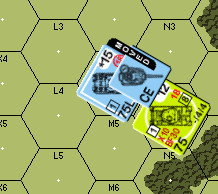
In this example, it is the German player’s turn. The Panther has moved to a point blank position and is preparing to Stop. Doing the math in his head, the American player realizes he cannot win a Gun Duel if he waits for the Panther to Stop. Instead, the American player opts to attack upon entry into M4.
The attack is at normal range. The only other modifier to the Basic TK# is a +1 because the Panther is CE. The Modified TK# is a 9. No other DRMs apply. Even though the Panther is Non-Stopped, the Sherman is BU AND has to pivot 2 hexsides to bring its bow-mounted FT to bear on the Panther, these do not matter. The attack eliminates the Panther as a burning wreck on a TK DR ≤ 8. A TK DR = 9 eliminates the Panther and the German player may roll for Crew Survival. A TK DR ≥ 10 does not affect the Panther and it Disables the Sherman’s FT too. Keep in mind, even though the FT Malfunctions, this still attacks vulnerable PRC on the 30 column with a +2 CE DRM (A9.7).

Final Thoughts on FT Attacks
At the risk of being pedantic, I circled a portion of the HE And Flame To Kill Table to emphasize its importance. This is not as clearly stated in the rulebook as it should be, but the table is very clear. There are only 4 possible modifiers to the Basic TK# listed in the chart.
Steve Pleva: Albany Tournament Director
The Albany FT versus AFV rule attempts to address what was clear to Gary and me that the original rule didn’t fully think through the prospect of FTs vs AFVs, especially by a vehicular bow mounted FT. For example, according to the RAW, a vehicular bow mounted FT that is: In Motion, changing three covered arcs and firing through +5 hindrance will still kill an enemy AFV that spent 1 MP in LOS on DR <= 8. That seems quite silly to me.
The Albany FT vs AFV rule is a compromise. It attempts to factor in some of these effects without getting too complicated. In my opinion, the proper “fix” is to add a TH DR to the FT versus AFV process. The TH would be 12 in hex, 11 in an adjacent hex and 10 for a normal range two hex shot. Long range (2 or 3 hex range depending on FT type) TH would be a 6 TH. Then if a hit is achieved use the 8 TK number. This would keep the TK chances between a stationary firer and stationary target about the same. I would ignore target size for this purpose considering that a FT is a quasi area weapon. A King Tiger would not be easier to kill than a TKS when using a FT.
Molotov Cocktails
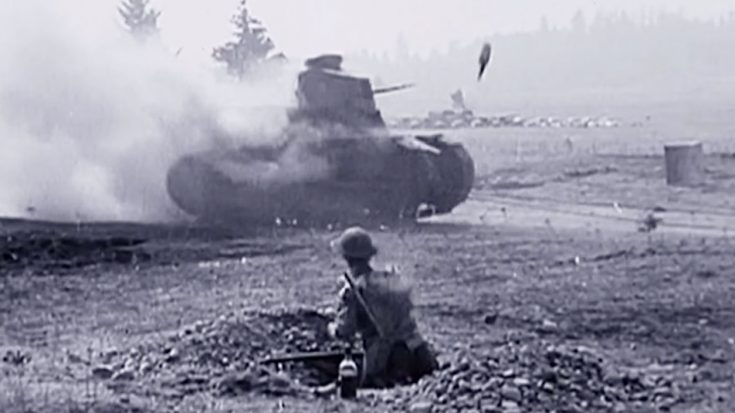
Molotov Cocktails (MOL) are available only if allowed by SSR. They are an Inherent SW of any Personnel 2 unit when present. MOL are not represented by a counter. Any unpinned Good Order/Berserk Personnel unit can use a MOL in three ways. In this article, we will only cover their usage against AFVs.
To use a MOL against an AFV, the AFV must be pre-designated as the target. The Personnel unit must be in Point Blank or Triple Point Blank range. Prior to resolving the attack, make a MOL Check dr. On a dr ≤ 3 (Δ) the firing unit has a MOL. There is a +1 drm for a crew/half squad, +2 for a SMC, +1 if CX, and a +1 drm if the MOL is not targeting an AFV.
Resolve a MOL attack versus an AFV on the HE and Flame To Kill Table. As noted previously, the only modifiers to the TK DR are on the chart. One notable difference is Open Top and CE do not combine like they do for a flamethrower attack. For a MOL attack, it is either/or; not both.

For the attack against the AFV, the Basic TK# is a 6. The modifiers are +1 CE or +2 Open Topped, +1/+2 for Elevation advantage (C7.22), +1 for attacking the AFV’s rear aspect, and -2 versus a Moving Target (C.8). If the AFV is in the same hex as the attacker, the MOL automatically hits the rear. Make a DR and compare to the Modified TK# derived. If the Final TK DR is < the Modified TK#, eliminate the AFV as a Burning Wreck. If the Final TK DR is = the Modified TK#, eliminate the AFV with possible Crew Survival.
If the AFV survives, the Inherent FP plus the MOL’s 4 FP attack the AFV’s vulnerable PRC as a Specific Collateral Attack. The attack affects all other vulnerable units in the Location with the unit’s Inherent FP only. The attack DR also has other consequences. If the colored die is a 1, place a Flame in the target Location if it contains Burnable Terrain.
Example 3
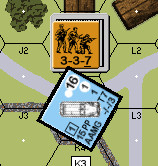
It is the Partisan Prep Fire Phase. The Partisan MMC declares a MOL attack against the ht and subsequently succeeds on his MOL Check dr. The Basic TK# is a 6. There is a +2 modifier for Open Top and a +2 Modifier for Elevation Advantage against an Open Topped vehicle. Notice there is no CE modifier since it is mutually exclusive with the Open Topped Modifier. The resultant Modified TK# is a 10. On a TK DR of ≤ 9, the ht is eliminated as a Burning Wreck. A TK DR = 10 eliminates the AFV and the German player may roll for Crew Survival. On a DR 11-12, the AFV is unaffected, but the PRC is attacked with a Specific Collateral Attack.
Suppose the 3-3-7 was on the second level. In that case, the elevation difference exceeds the range, lowering the CE DRM to +1. This attack would be through an unarmored aspect (D5.311). Such an attack from level two would be an 8 FP attack (3 x 2 + 4 = 10) on the ★ Vehicle line of the IFT. Eliminate the ht as a Burning Wreck on a DR 6. On a DR 7, eliminate the ht and the German player can roll for Crew Survival. A DR ≥ 8 does not affect the ht.
Vulnerable PRC are also attacked on the 8 column if the ht is unaffected. Here, if the DR is an 8, the ht is unaffected BUT the PRC would take a NMC. If the Crew fails this NMC, it doesn’t Stun; it breaks. I refer you to my previous article Defending Against Sleaze Freeze – Second Example for more complete details.
Finally, if the colored die of the TK DR is a 1, place a Flame in the Ground floor of K2 regardless of the outcome against the ht. If the colored die of the TK DR is a 6, break the Partisan squad. Once broken, the MOL and PBF from unit do not apply to the attack letting the ht live to see another day.
Example 4

It is the German MPh. The Panther announces a bypass of M4 for 2 MPs. The Partisan Player declares a MOL attack against the Panther and succeeds on his MOL Check dr. Before modifiers, the Basic TK# is 6. The modifiers are +1 Modifier for Elevation Advantage and a -2 for a Moving Target. Again, the target is in the attacker’s hex, so it strikes the rear target facing for an additional +1 Modifier. The Modified TK# is 6. Eliminate the Panther as a Burning Wreck on a TK DR ≤ 5. Destroy the Panther on a TK DR = 6 but the German player may roll for Crew Survival. A TK DR ≥ 7 does not affect the Panther.
Regardless of the outcome against the Panther, place a Flame in the Target’s Location if the colored die of the TK DR is a 1. Break the Partisan if the colored die of the TK DR is a 6, and void the attack. Since there is no vulnerable PRC in this example, there is no Specific Collateral Attack.
Example 5

It is the German player’s MPh, and the Panther is on the move. The Partisan player declares a MOL attack against the Panther and succeeds on his MOL Check dr. The Basic TK# is 6. There is a -2 Modifier because the Panther is a Moving Target. The Partisan’s TK DR will determine the Target Facing, which will be important in this case. On a Hull hit, it hits the rear aspect of the AFV and increases the Modified TK# by 1. On a turret hit, the Modified TK# does not gain this additional +1. The Modified TK# is 4/5 for a TCA/VCA hit.
I will leave further resolution of this attack as an exercise for the reader. Having covered two other examples, I am sure you have the tools. Don’t forget about the effects of the colored die on the TK DR.
Molotov Projector (MOL-P)
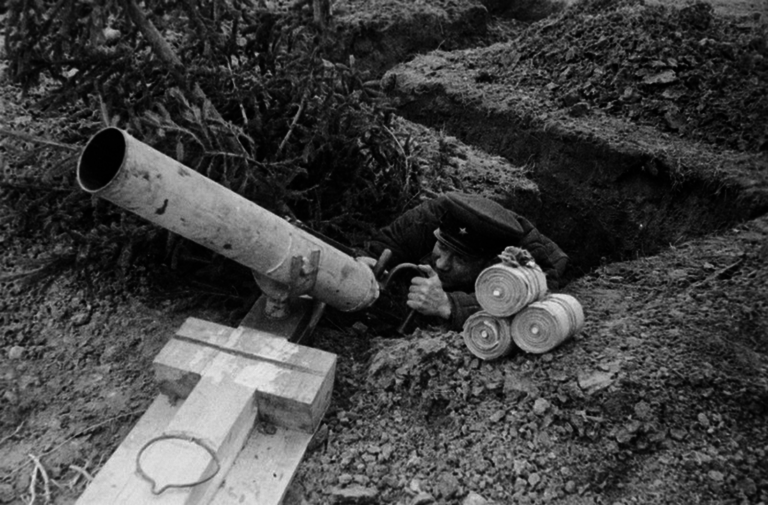
A Molotov Projector is a crew-served Light Anti-Tank Weapon (LATW). Like other ½” LATWs it has its own To Hit Table printed on the back of the counter. Unlike MOLs and FTs, a MOL-P can achieve a Critical Hit on an Original TH DR 2 (C13.52). Unlike other MOL attacks, a MOL-P attack is an ordnance attack and never combines with small arms. While the MOL-P has additional capabilities, we will just focus on its anti-tank capabilities here in this article.

When attacking an AFV, a MOL-P must first secure a hit using the To Hit Table on the back of the counter. Like other LATW, it uses the same TH DRM found on the C5 and C6 tables found on the QRDC (Cases A through R, except those NA to LATW). Once a hit is secured, conduct the attack against the AFV exactly as if hit by a MOL, except here are only two possible modifiers to the Basic TK#: +1 for hitting an Open Topped AFV, +1 for hitting an AFV in the rear. Of course, double the Basic TK# if the MOL-P scores a Critical Hit.
Finally, a MOL-P also inflicts a 4 FP Specific Collateral Attack on vulnerable PRC as part of the attack.
Example 6
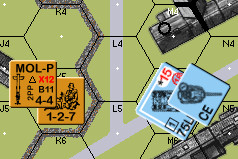
It is the Russian Prep Fire phase. The Crew in K5 opts to fire the MOL-P at the Panther in M5. According to the back of the counter, the Basic TH# is 8 at range 2. Target Based Case P adds a -1 DRM. The MOL-P hits on an Original TH DR ≤ 9. Assume the attack subsequently hits.
The Basic TK# for a MOL is 6. There is a +1 for attacking a rear Target Facing. Although CE would apply to a normal MOL attack, it does not apply to an attack from a MOL-P (C13.54). The Modified TK# is a 7. Eliminate the Panther as a Burning Wreck on an Original DR ≤ 6. On an Original DR = 7, eliminate the Panther and the German player can roll for Crew Survival. A MOL-P inflicts a Specific Collateral Attack on any attack that doesn’t destroy the target. There is no DR which doesn’t destroy the AFV that could otherwise hurt the Crew.
Now, imagine the MOL-P rolled an original 2 on its TH DR scoring a Critical Hit. This would double the Basic TK# to 12 before modifying to 13 based on hitting the rear Target Facing. Since there are no Duds with fire, the result is a Burning Wreck on any Original DR.
Parting Thoughts on Killing Things with Fire
- The HE and Flame To Kill Table lists the only Modifiers to the Basic TK#.
- When an AFV with Red Crew Survival numbers (CS#) is eliminated with flame, it has a -1 DRM to determine if it is eliminated as a Burning Wreck (C5.7). An AFV with Red CS#s is always eliminated as a Burning Wreck when attacked by fire.
- Armor Factors do not apply when killing things with fire. All that matters is the TK# and the DR. You can lay low even the largest, most invulnerable AFV with a bottle full of gasoline. This comes as a surprise to some ASL players.
Conclusion

I must confess, before writing this article, I hadn’t spent a lot of time considering how AFVs are killed by fire. A reader asked me to consider writing this article so I conducted the deep dive necessary to author this. I hope this article meets his expectations. It was a lot of fun coming up with examples and taking the time to consider the implications of these attacks.
As I continue to explore Infantry versus AFV tactics, I am having a good time expanding my thinking. Even with as much ASL as I have played in my time, I find I am still learning new things and I count some of the information in this article among those new things. I hope some find this helpful. Until next time. – jim

